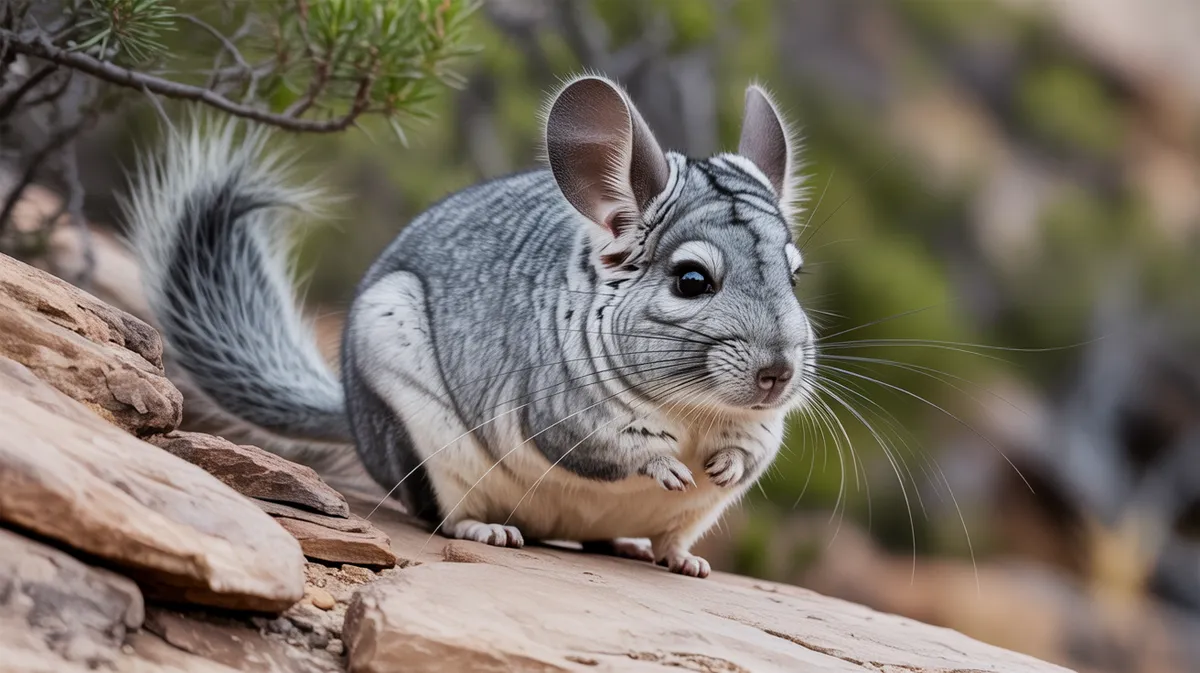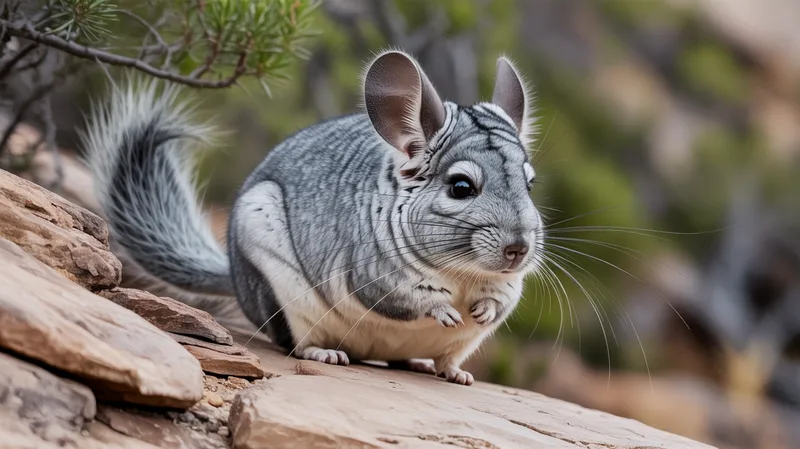
Long-tailed Chinchilla
Chinchilla lanigera

Meet the Long-tailed Chinchilla
The Long-tailed Chinchilla is a small, nocturnal rodent native to the rugged Andes mountains of northern Chile. Known for its incredibly dense, soft fur, this species was once hunted nearly to extinction for the fur trade. It has large, rounded ears, a bushy tail, and powerful hind legs adapted for leaping among rocky outcrops. Long-tailed Chinchillas are highly social, often living in colonies, and are active mainly during dusk and night.
Classification
Mammal
Habitat
Rocky mountain slopes and arid shrublands
Diet
Herbivore
Lifespan
8-10 years in the wild, up to 15 years in captivity
Conservation
Endangered
Weight
400-600 grams
📖Fascinating Facts
Fur Density Champion
Long-tailed Chinchillas have the densest fur of any terrestrial mammal, which helps them survive the cold Andean nights.
Nocturnal Lifestyle
These animals are primarily active at night, foraging for food and socializing within their colonies.
Mountain Dwellers
They are specially adapted for life among rocky crevices and steep slopes, using their agility and leaping ability to escape predators.
📋Detailed Description
The Long-tailed Chinchilla (Chinchilla lanigera) is a small, robust rodent typically weighing between 400 and 600 grams, with a body length of 22–38 cm and a distinctive bushy tail measuring 10–15 cm. Its most notable feature is its extraordinarily dense, silky fur, with up to 60–80 hairs growing from a single follicle—an adaptation to the cold, arid environment of the Andes. The fur is usually bluish-grey above and paler below, providing camouflage among rocky outcrops. The species has large, rounded ears (up to 4 cm) that enhance auditory sensitivity and aid in thermoregulation, and prominent black eyes adapted for nocturnal vision. Long-tailed Chinchillas possess powerful hind limbs and elongated hind feet, enabling agile leaps of up to 2 meters between rocks. Their dexterous forepaws are used for grasping food and grooming. Socially, they are highly gregarious, forming colonies (or herds) that can number from a few individuals to over 100, which provides protection from predators. Communication is achieved through a range of vocalizations, scent marking, and complex social grooming behaviors. In the wild, their lifespan is typically 8–10 years, but in captivity, they may live up to 20 years.
💡 Did you know?
Wild populations of Long-tailed Chinchillas survive in only a handful of small, isolated colonies in Chile, making them one of the rarest mammals in the world.
🔬Research & Sources
Wikipedia Summary
The long-tailed chinchilla, also called the Chilean, coastal, common, or lesser chinchilla, is one of two species of rodent from the genus Chinchilla: the other species being C. chinchilla. Both species are endangered in the wild after historically being hunted for their soft hair coats. Domestic breeds of chinchilla are believed to descend from specimens of C. lanigera. Domestic chinchillas come in three types: la plata, costina, and raton.
Last Modified: 1/22/2025
🎭Behavior & Social Structure
Long-tailed Chinchillas are crepuscular to nocturnal, emerging at dusk to forage and remaining active throughout the night. They are strict herbivores, feeding on a variety of native grasses, seeds, leaves, and bark, with a preference for high-fiber, low-moisture plants adapted to arid conditions. Foraging is a group activity, and individuals use their sensitive whiskers and acute sense of smell to locate food. They exhibit dust-bathing behavior, rolling in fine volcanic ash or dust to maintain fur health and remove parasites. Social interactions are complex, involving grooming, vocalizations (such as chirps, barks, and squeaks), and hierarchical behaviors, with dominant individuals controlling access to the best shelters and dust-bathing sites. When threatened, chinchillas may emit alarm calls, spray urine, or shed fur patches (fur-slip) as a defense mechanism.
👶Reproduction & Life Cycle
Long-tailed Chinchillas are seasonally polyestrous, with breeding typically occurring during the Southern Hemisphere's late winter to early summer (November to May). Mating is preceded by courtship behaviors, including grooming and vocalizations. Females are induced ovulators and dominant within the social hierarchy. Gestation lasts approximately 111 days, one of the longest among rodents. Litters usually consist of 1–3 precocial young (kits), born fully furred, with open eyes and the ability to move within hours. Parental care is primarily provided by the female, though males may assist with grooming and protection. Kits are weaned at 6–8 weeks and reach sexual maturity at 8–12 months.
🛡️Adaptations & Survival
Chinchilla lanigera exhibits several unique adaptations for survival in its harsh Andean environment. Its dense fur provides exceptional insulation against cold temperatures and reduces water loss. The species has a low metabolic rate and efficient kidneys, allowing it to survive on minimal water intake. Large ears and a highly vascularized tail help dissipate excess heat. Their powerful hind legs and flexible spine enable agile movement across steep, rocky terrain. Behavioral adaptations include dust bathing for fur maintenance and living in complex burrow systems or rock crevices to avoid predators and extreme weather.
📚Research Sources
🎨Cultural Significance
Long-tailed Chinchillas have played a significant role in human culture, particularly in the fur trade, where their pelts were considered among the finest and most luxurious. Indigenous peoples of the Andes occasionally hunted chinchillas for food and used their fur for clothing. In modern times, the species has become a symbol of wildlife conservation in Chile and is the progenitor of all domestic chinchilla breeds kept as pets and used in scientific research. The animal is sometimes featured in local folklore as a symbol of agility and resilience.
🔬Recent Research & Discoveries
Recent research has focused on the genetic diversity of wild populations, revealing low variability due to historical overhunting and habitat fragmentation. Studies on physiological adaptations have highlighted the chinchilla's remarkable water conservation mechanisms and fur structure, with implications for biomimetic materials science. Conservation programs are investigating habitat restoration, captive breeding, and reintroduction strategies. Behavioral studies in both wild and captive populations have provided insights into social structure, stress responses, and enrichment needs. Ongoing monitoring using camera traps and genetic markers aims to better estimate population sizes and connectivity.
🎥Wildlife Videos

Chinchilla - 5 Minute Documentary
Embark on an enchanting five-minute documentary that delves into the whimsical world of the chinchilla, a creature of remarkable ...
Five Minute Documentaries

Chinchillas! What, Where, and How
Jessi shares what Chinchillas are, where the come from, and how to care for them in captivity. Featuring Cheerio the chinchilla!
Animal Wonders Montana

Corto Documental Reserva Nacional Las Chinchillas
Una coproducción DOLLYBACK PRO y Revista BIOMA para difundir el patrimonio natural y cultural de Chile.
DOLLYBACK PRO Producciones audiovisuales

Chinchilla Facts (Happy Earth Day)
Sadly Chinchillas are endangered in the wild and still being hunted for their fur. It takes 150 Chinchilla pelts to make one fur coat.
Chewy the Chinchilla

Reserva Nacional Las Chinchillas
Marcos Burgos Corp. les trae este gran documental.
Eitan Dines

Chinchilla Movie ep.5 -The New House Tour
Chinchilla Movie ep.5 -The New House Tour Hello and welcome everyone of you! Chinchilla home here! We maKe funny movies ...
CHINCHILLA HOME
🌍Habitat Information
The Long-tailed Chinchilla typically inhabits Rocky mountain slopes and arid shrublands environments. Long-tailed Chinchillas have adapted to their environments with specialized features and behaviors.
Primary Habitat:
Rocky mountain slopes and arid shrublands
More detailed habitat information will be available soon.
🛡️Conservation Status
The Long-tailed Chinchilla is currently classified as Endangered. Conservation efforts are crucial for preserving this species for future generations.
Common Threats:
- 🏠Habitat loss and fragmentation
- 🌡️Climate change impacts
- 🎯Hunting and poaching
- 🏭Human-wildlife conflict
⚠️Threats & Conservation Challenges
The primary threat to Long-tailed Chinchillas is illegal hunting for their highly prized fur, which led to catastrophic population declines in the 19th and 20th centuries. Habitat destruction from mining, agriculture, and infrastructure development continues to fragment their range. Predation by native and introduced species (e.g., foxes, owls, feral cats) poses additional risks. Small, isolated populations are vulnerable to genetic bottlenecks, disease, and environmental changes. Despite legal protections (IUCN Endangered, CITES Appendix I), enforcement is inconsistent, and wild populations remain critically low, estimated at fewer than 10,000 mature individuals.
🔬Scientific Classification
Scientific Name
Chinchilla lanigera
Classification Hierarchy
🔍 About Taxonomic Classification
Taxonomic classification is a hierarchical system used by scientists to classify and organize living organisms based on shared characteristics and evolutionary relationships.
The system moves from broad categories (Kingdom) to increasingly specific ones, with each animal's scientific name typically consisting of its Genus and species.
📝Community Notes
Share your observations and insights about the Long-tailed Chinchilla with our community of wildlife enthusiasts.
Join Our Community
Sign in to share your observations and connect with fellow wildlife enthusiasts.
Sign In to ContributeNo community notes yet
Be the first to share your observations about the Long-tailed Chinchilla!
Explore Long-tailed Chinchilla
Select a tab above to learn more about this amazing animal.
📸Photo Gallery
No photos available for this animal yet.
🌟Discover More Wildlife
Continue your journey of discovery with more fascinating animals from our database
